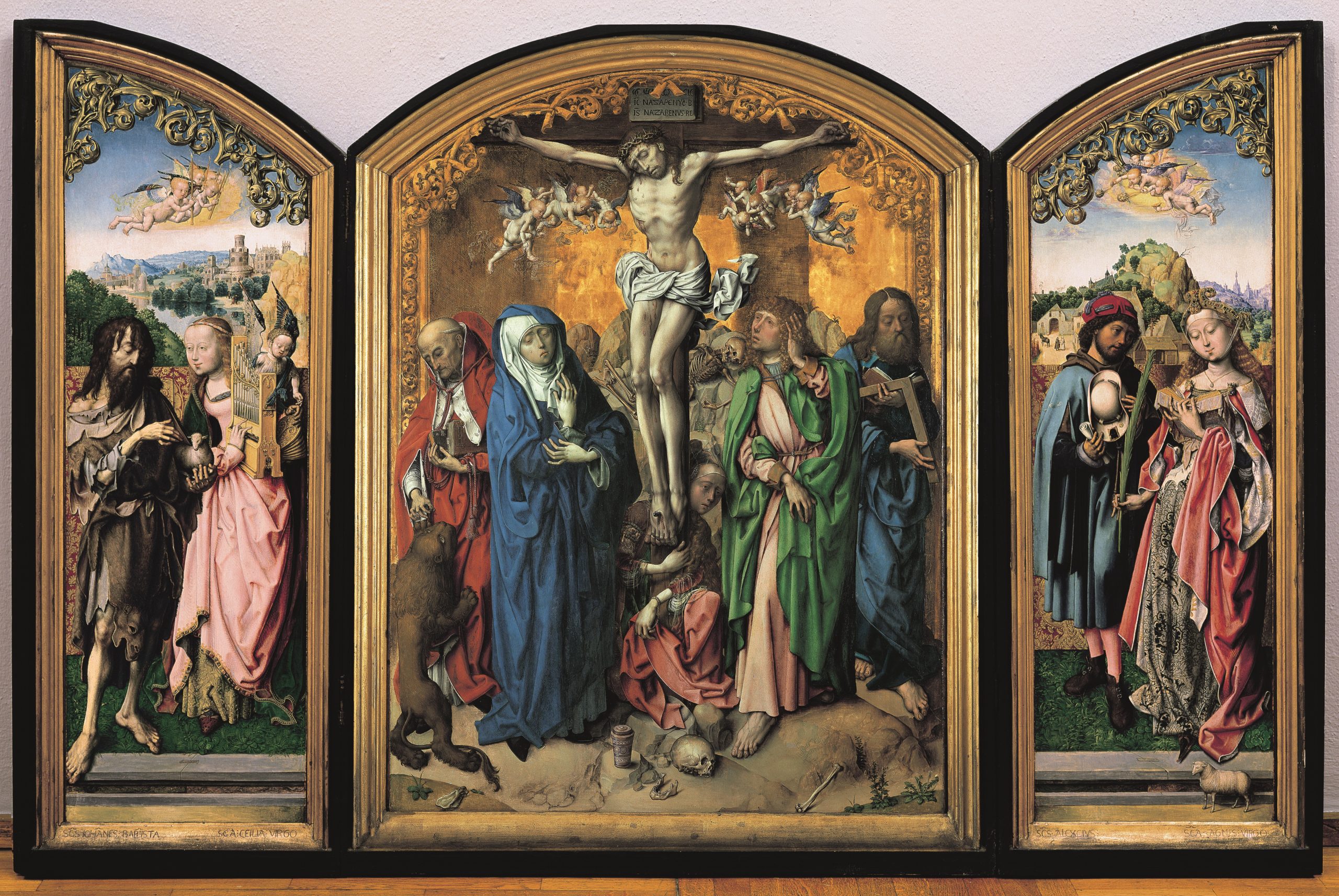Cross-Altar
c. 1490-1495 | MASTER OF THE SAINT BARTHOLOMEW ALTARPIECE (Active in the Netherlands, c. 1475 – 1510)
Optical Illusion
The central panel of this three-part altarpiece (triptych) creates the illusion of carved figures. And the painted wooden sculptures of the saints also seem to come to life! The Resurrection of Christ is anticipated as it were by this sophisticated game with the media. Moreover, the illusion continues on the outside of the wings: the everyday side in shades of grey suggests niches containing sculptures which, however, were to be envisaged as carved in unpainted stone. These profound, at times humorous illusions or »trompe-l’oeil« effects permit us to assume that the work was commissioned by a discerning client with a well-trained eye. Like the St Thomas Altar, the Altarpiece of the Holy Cross was commissioned by the lawyer Dr. Peter Rinck, who later bequeathed this triptych to a cloister of the Carthusian Order in Cologne. He may well have viewed this as the altar’s ultimate location from the outset, because the inside of the right-hand wing depicts such a Carthusian cloister. The background on the inside of the left wing shows a riverscape that is meant to be the Valley of Jordan, and thus the region where John the Baptist (front left) performed his mission. Typical of this painter’s extraordinary precision is the trilingual (Hebrew-Greek-Latin) inscription on the cross, which only shortly before was believed to have been rediscovered in Rome (in 1492). The passages of text that were destroyed through material loss to the relic have been discreetly covered over in the painting. Moreover the artist has corrected a demonstrably wrong letter in the »original inscription«. Since the wording on the cross was ultimately a legal document, it was clearly of great importance to Peter Rinck.
Oak wood, 107 x 80 cm (central panel), 107 x 34 cm (wing)
Acquired 1862 with support of the Richartz-Fonds
WRM 180
Einblicke in die restauratorischen und konservatorischen Maßnahmen
Als am 12. Mai 2014 Gerrit van Honthorsts großformatiges Gemälde „Anbetung der Hirten“ zur genaueren Prüfung des Erhaltungszustandes in die hauseigene Abteilung für Kunsttechnologie und Restaurierung gebracht wurde, kam mit einer ungeahnten Entdeckung ein Stein ins Rollen.
Zeigte sich doch am oberen Rand überraschender Weise ein ca. 12,5, cm hoher Streifen der bemalten Leinwand, der auf die Rückseite des Keilriemens umgeschlagen war.
Das Bildformat war also um ein beträchtliches Stück in der Höhe verkürzt worden.

Zustand des Gemäldes vor der Restaurierung im verkürzten Format mit ehemaligem Zierrahmen

Rückseite des Gemäldes mit sichtbarem Umschlag der bemalten Leinwand auf der Keilrahmenrückseite.
Rechts ein Detail mit erkennbarer Körperbindung des blau gestreiften Gewebes.

Zustand des Gemäldes im Originalformat nach der Restaurierung durch Robert Hieronymi im Jahr 1940.

Foto von 1946 mit erkennbaren Laufspuren aufgrund eines Wasserschadens.

Kartierung des blauen Streifenmusters und aller Maße der insgesamt drei Gewebeteile, aus denen sich der textile Bildträger zusammensetzt.

Detail aus: Jan Steen, Amnon und Thamar (WRM 2536) mit blau gestreifter Matratze, deren Muster der Leinwand von Honthorsts „Anbetung der Hirten“ gleicht.

Röntgenbild, Gesamtaufnahme.
